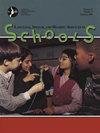儿童、家长和专家对言语和沟通的感知。
IF 2.9
3区 医学
Q1 AUDIOLOGY & SPEECH-LANGUAGE PATHOLOGY
Language Speech and Hearing Services in Schools
Pub Date : 2025-07-15
DOI:10.1044/2025_lshss-24-00140
引用次数: 0
摘要
目的本研究旨在提高我们对言语障碍儿童(SSD)与正常发育儿童(TD)相比如何感知自己的言语和交流的认识,以及这些感知如何与父母对交际参与的判断、不同情境下的可理解性以及儿童言语准确性的专家测量(音节初始位置上的辅音正确百分比[PCCI])相关。方法研究对象为111名荷兰语儿童(48-89个月):65名患有SSD, 46名患有TD。对荷兰版《学龄前和幼儿园口吃儿童沟通态度测验》(KiddyCAT-NL)儿童自我报告进行比较(a) SSD组与TD组之间的比较,(b)与家长评分的比较。父母的评分来自两份父母问卷:关注6 -34岁以下交际结果:荷兰语(Focus - 34nl)测量交际参与和语境可理解性量表:荷兰语(ICS-NL)。KiddyCAT-NL、FOCUS-34NL和ICS-NL结果也与(c)语音语言病理学家(slp)使用计算机发音仪的图片命名任务作为PCCI测量的语音准确性进行比较。结果统计分析显示,SSD组幼儿对言语和交流的感知与TD组儿童存在差异。只有在SSD组中,语音准确性和语境中的可理解性之间存在适度的正相关,而与儿童的言语和沟通感知之间只有微弱的相关。父母和孩子的认知是弱相关的。结论儿童对自身言语的感知信息与父母和语言障碍者对言语准确性的正式评估信息是互补的。因此,为了充分了解语言和交际能力的影响,积极引导并纳入儿童对语言和交际的看法是很重要的。本文章由计算机程序翻译,如有差异,请以英文原文为准。
Children's, Parents', and Experts' Perception of Speech and Communication.
PURPOSE
This study aims to improve our knowledge of how young children with speech sound disorders (SSD) perceive their own speech and communication in comparison with typically developing (TD) children and how these perceptions relate to parental judgment of communicative participation, intelligibility in different contexts, and an expert measure of children's speech accuracy (percentage of consonants correct in syllable initial position [PCCI]).
METHOD
Participants were 111 Dutch-speaking children (48-89 months old): 65 with SSD and 46 who were TD. Children's self-reports on the Dutch version of the Communication Attitude Test for Preschool and Kindergarten Children Who Stutter (KiddyCAT-NL) were compared (a) between SSD and TD groups and (b) with the parents' ratings. Parents' ratings were obtained from two parental questionnaires: Focus on the Outcomes of Communication Under Six-34: Dutch (FOCUS-34NL) measuring communicative participation and the Intelligibility in Context Scale: Dutch (ICS-NL). The KiddyCAT-NL, FOCUS-34NL, and ICS-NL outcomes were also compared with (c) speech accuracy measured by speech-language pathologists (SLPs) as the PCCI using the picture-naming task of the Computer Articulation Instrument.
RESULTS
Statistical analysis revealed that young children in the SSD group perceived their speech and communication differently than children in the TD group. Only in the SSD group was there a moderate positive correlation between speech accuracy and intelligibility in context and only a weak correlation with the child's perception of speech and communication. Parents' and children's perceptions were weakly correlated.
CONCLUSIONS
Information on children's perception of their own speech is complementary to information obtained from the parents and SLPs' formal assessment of speech accuracy. To fully understand the impact of SSD, it is therefore important to actively elicit and include children's perspectives on speech and communication.
求助全文
通过发布文献求助,成功后即可免费获取论文全文。
去求助
来源期刊

Language Speech and Hearing Services in Schools
Social Sciences-Linguistics and Language
CiteScore
4.40
自引率
12.50%
发文量
165
期刊介绍:
Mission: LSHSS publishes peer-reviewed research and other scholarly articles pertaining to the practice of audiology and speech-language pathology in the schools, focusing on children and adolescents. The journal is an international outlet for clinical research and is designed to promote development and analysis of approaches concerning the delivery of services to the school-aged population. LSHSS seeks to advance evidence-based practice by disseminating the results of new studies as well as providing a forum for critical reviews and meta-analyses of previously published work.
Scope: The broad field of audiology and speech-language pathology as practiced in schools, including aural rehabilitation; augmentative and alternative communication; childhood apraxia of speech; classroom acoustics; cognitive impairment; craniofacial disorders; fluency disorders; hearing-assistive technology; language disorders; literacy disorders including reading, writing, and spelling; motor speech disorders; speech sound disorders; swallowing, dysphagia, and feeding disorders; voice disorders.
 求助内容:
求助内容: 应助结果提醒方式:
应助结果提醒方式:


